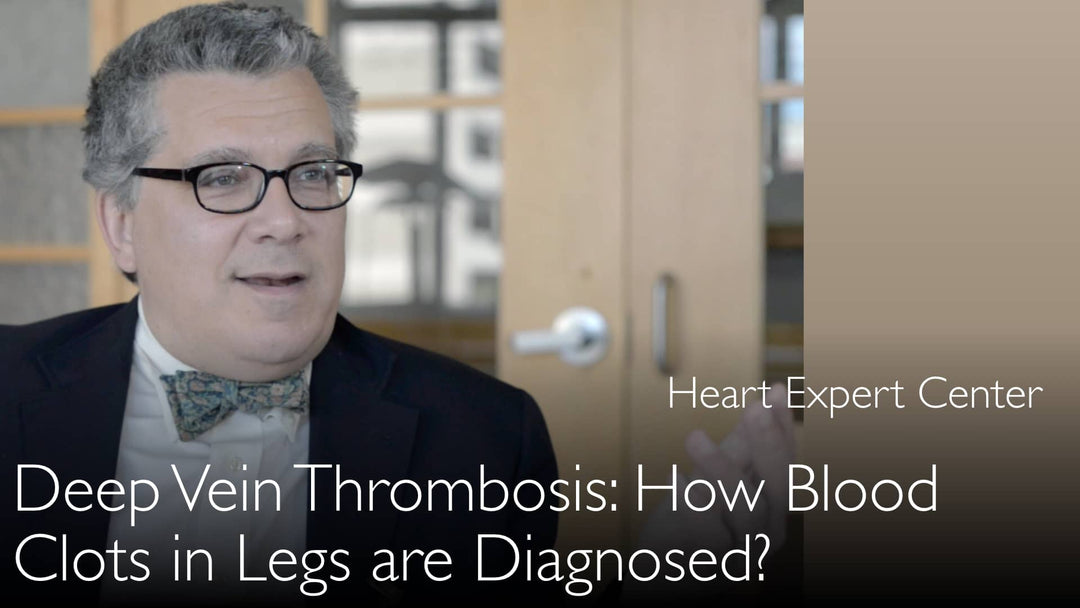Leading expert in vascular imaging, Dr. Kent Yucel, MD, explains how to diagnose deep vein thrombosis (DVT) and pulmonary embolism. Ultrasound is the primary test for finding blood clots in the legs. CT scan with intravenous contrast is the gold standard for diagnosing clots in the lungs. Dr. Yucel details specific patient presentations and when advanced imaging like CT or MRI becomes necessary.
Diagnosing Deep Vein Thrombosis and Pulmonary Embolism: Best Imaging Tests
Jump To Section
- Ultrasound as the First Test for DVT
- When CT or MRI is Better Than Ultrasound
- Diagnosing Pulmonary Embolism with CT
- Patient Presentation and Symptoms
- Importance of a Medical Second Opinion
- Full Transcript
Ultrasound as the First Test for DVT
Ultrasound is the primary and most effective diagnostic test for deep vein thrombosis in the legs. Dr. Kent Yucel, MD, a leading radiologist, confirms that for patients presenting with leg symptoms, an ultrasound is the immediate test of choice. This non-invasive imaging technique is highly sensitive for detecting clots in the deep veins of the legs.
Dr. Kent Yucel, MD, notes that while CT or MRI can be used, they are not superior to ultrasound for identifying small leg clots. These small clots can be significant as they may dislodge and lead to larger complications, such as a pulmonary embolism. The interview with Dr. Anton Titov, MD, highlights that ultrasound's role is central to the initial DVT diagnostic pathway.
When CT or MRI is Better Than Ultrasound
CT or MRI becomes the preferable imaging modality for DVT diagnosis in specific, specialized patient groups. Dr. Kent Yucel, MD, explains that ultrasound has a significant limitation: it cannot visualize the pelvic veins well. This makes advanced imaging critical for patients with suspected clots originating in the pelvis.
Patients who have undergone pelvic surgery, such as for uterine cancer, or those with pelvic tumors are at risk for clots in these deeper veins. In these cases, Dr. Kent Yucel, MD, states that CT or MRI is necessary to obtain a clear diagnosis, as ultrasound may only show indirect signs of a blockage without revealing its cause.
Diagnosing Pulmonary Embolism with CT
A CT scan with intravenous contrast is the definitive test for diagnosing a pulmonary embolism. Dr. Kent Yucel, MD, emphasizes that for patients presenting with lung symptoms like shortness of breath, CT is the diagnostic gold standard. This method, often called a CT pulmonary angiogram, provides detailed images of the blood vessels in the lungs.
Dr. Yucel clarifies that neither ultrasound nor MRI are suitable alternatives for evaluating pulmonary embolism. Ultrasound cannot penetrate lung air, and MRI technology is not yet sufficiently advanced for this specific application. The conversation with Dr. Anton Titov, MD, underscores that a well-timed IV dye injection during the CT scan is crucial for an accurate PE diagnosis.
Patient Presentation and Symptoms
Patients with deep vein thrombosis typically present in one of two distinct ways, guiding the diagnostic approach. Dr. Kent Yucel, MD, outlines that a patient will either have symptoms in the leg from the clot itself or symptoms in the lungs from a clot that has traveled, causing a pulmonary embolism.
Leg symptoms often include pain, swelling, redness, and warmth in the affected limb. Lung symptoms from a pulmonary embolism are more acute and can include sudden shortness of breath, chest pain, and coughing up blood. Dr. Yucel stresses that a pulmonary embolism can be fatal in up to 30% of cases, making prompt and accurate diagnosis critical.
Importance of a Medical Second Opinion
Seeking a medical second opinion is a vital step after a diagnosis of deep vein thrombosis or pulmonary embolism. Dr. Kent Yucel, MD, and Dr. Anton Titov, MD, discuss how a second opinion confirms the accuracy and completeness of the initial diagnosis. This is especially important given that ultrasound can sometimes yield false negatives by missing small clots below the knee.
A second review ensures the chosen treatment strategy is the most effective for the individual patient. It provides confidence and peace of mind, ensuring that all diagnostic possibilities, including hard-to-find pelvic clots, have been thoroughly evaluated.
Full Transcript
Dr. Anton Titov, MD: How is DVT diagnosed? How to find blood clots in legs? When does CT or MRI become better than ultrasound to look for blood clots in veins?
A leading CT and MRI radiologist with a special interest in vascular imaging discusses the best methods to diagnose blood clots in the legs and deep venous thrombosis.
Dr. Anton Titov, MD: How is DVT diagnosed? How to find blood clots in legs? How is pulmonary embolism diagnosed?
Dr. Kent Yucel, MD: Ultrasound is the first test to diagnose deep vein thrombosis. CT scan with intravenous contrast is used to diagnose pulmonary embolism.
Deep vein thrombosis tests and diagnosis start with an ultrasound of the legs. A DVT ultrasound can be falsely negative because small clots below the knee could be missed.
To establish a pulmonary embolism diagnosis, it is necessary to do a spiral CT scan with a well-timed IV dye injection. A medical second opinion when blood clots in the legs are found ensures that the diagnosis is correct and complete.
A medical second opinion also helps to choose the best treatment strategy for deep vein thrombosis and pulmonary embolism. Seek a medical second opinion on deep vein thrombosis and be confident that your treatment is the best.
Dr. Anton Titov, MD: How to find blood clots in legs?
Dr. Kent Yucel, MD: Embolism of the pulmonary artery can be fatal in up to thirty percent of patients. Yes, and the most frequent cause is deep venous thrombosis. DVT is the presence of blood clots in the deep veins of the legs.
Dr. Anton Titov, MD: You have published a number of important papers on imaging studies of peripheral blood vessels, including papers on multimodality assessment of leg veins. What is the approach a person with suspected or known problem with blood clots in leg veins, DVT deep vein thrombosis, can take to evaluate the situation and make sure that the event of pulmonary artery embolism is prevented?
Dr. Kent Yucel, MD: A patient with DVT is going to present in one of two ways. They can either present with leg symptoms due to clots in the legs, or they can present with lung symptoms like shortness of breath or coughing up blood due to a clot from the legs having already gone to the lungs. That is a different approach depending on how they present.
People who present with leg vein symptoms get an ultrasound right now of the legs. Ultrasound is the test of choice for leg veins. CT or MRI can be helpful, but they are not as good as ultrasound at finding small clots that can lead to bigger problems later on. So ultrasound of the legs is the way to go.
The only exception to that is patients who may have pelvic disease or pelvic surgery, who may develop blood clots not in the legs but in their pelvic veins, because ultrasound can't see the pelvic veins well. Sometimes ultrasound can show a hint that maybe something is wrong with the pelvis, or the patient may have a known condition in the pelvis, like a tumor or surgery, that will lead the doctor to worry about that.
In those patients with blood clots in pelvic veins, CT or MRI is preferable to ultrasound. Those are very special groups. For leg clots, ultrasound is the way to go.
For diagnosing clots that have gone to the lungs and are causing lung symptoms, CT is the diagnostic test of choice for a variety of reasons. MRI of the pulmonary arteries is not sufficiently good to evaluate for pulmonary embolism, and ultrasound cannot see through the lung air. So CT is the test of choice for pulmonary embolism evaluation.
Dr. Anton Titov, MD: Examples of pelvic disease, for example, if someone had surgery for uterine cancer or other tumors in the abdominal pelvic area, would be the types of diseases that could give rise potentially to clots in the pelvic vascular system.
Dr. Kent Yucel, MD: Exactly. Ultrasound of the legs can often show indirect signs that there is a blockage in the pelvic veins, but it may not be able to help determine what's causing the problem. Blood from surgery, a tumor, or a clot in pelvic veins can cause blockages, and ultrasound cannot tell them apart. That is where CT and MRI are most helpful.







